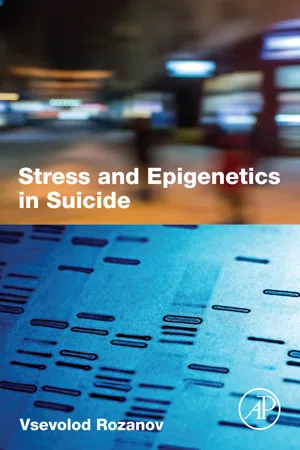
- 236 pages
- English
- ePUB (mobile friendly)
- Available on iOS & Android
Stress and Epigenetics in Suicide
About This Book
Stress and Epigenetics in Suicide discusses the central role of epigenetic modifications in suicidal behavior. As early-life stress and an individual's ability to cope with such stressors, combined with psychological factors, social factors, and existential and cognitive factors can predispose young people to suicidal behavior and put them at added risk of suicidal behavior later in life, this book provides readers with an overview of the neurobiology of stress, an introduction to the epigenetic changes induced by stress, and an understanding of how vulnerability and resilience to stress are built.
It integrates these mechanisms into a biobehavioral model of suicide based on epigenetic marks, gene-environment interactions, and other stressors. More importantly, it provides future direction for research and discusses potential interventions.
This book is an ideal and trusted resource for researchers and clinicians who are interested in learning how the environment can affect behavior through genetics, and for those seeking the development of new methods for suicide prevention.
- Explores the neurobiology of stress and stress-related epigenetics, including discussion of the role of stress-induced epigenetic changes in behavioral, emotional, and cognitive mechanisms and whether these epigenetic marks are transgenerational
- Provides compelling biobehavioral models of suicide based on genetics, epigenetics, and behavioral adjustment
- Integrates social, psychological, and existential influences, giving readers a better understanding of the interdisciplinary nature of suicide risk factors
- Presents future directions for suicide-prevention strategies that incorporate recent research on genomics and stress resilience
Frequently asked questions
Information
Recent Tendencies in Suicide and Mental Health Among Younger Generations and Current Explanations
Abstract
Keywords
Table of contents
- Cover
- Title page
- Table of Contents
- Copyright
- Introduction
- Chapter 1: Recent Tendencies in Suicide and Mental Health Among Younger Generations and Current Explanations
- Chapter 2: Neurobiology of Stress—From Homeostasis to Allostasis and How Social Environment is Involved
- Chapter 3: What Is Epigenetics? Is It Transgenerational?
- Chapter 4: Biological Embedding—How Early Life Stress Shapes Behaviors Later in Life and How Vulnerability is Built
- Chapter 5: Interactions and Integrations—Biobehavioral Model of Suicide Based on Genetics, Epigenetics, and Behavioral Adjustment
- Chapter 6: Ideas for Prevention
- Conclusions
- Index